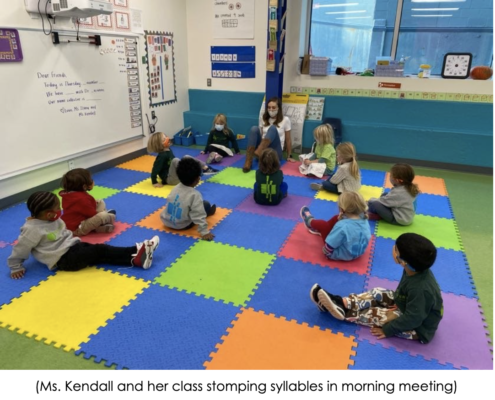by Kendall Doyle
As a preschool teacher, I think of my job as two primary responsibilities: teaching children how to go to school, and preparing them for future learning.
One of the biggest challenges preschool and pre-k teachers face is teaching students crucial literacy skills using developmentally appropriate strategies. This is where phonemic awareness comes in. Contrary to popular belief, phonemic awareness does not require any letter knowledge. This makes the tasks accessible to all students in preschool and pre-k classrooms, regardless of their trajectory of letter knowledge. The benefits of consistent, explicit phonological and phonemic instruction are enormous. Phonemic awareness means awareness of the smallest sounds of language (such as /s/). Phonological awareness is awareness of all the sound combinations in language and includes rhyming, syllables, and blending. Both are vital to prepare students for the future learning of reading and writing.
Results:
After consistently integrating phonemic awareness games and activities in my classroom, I have noticed a steady increase in the achievement of all of my students in phonemic and phonological awareness. This is especially true for my students who enter preschool or pre-k with little letter knowledge. (Note- if letter knowledge is concurrently taught systematically and explicitly, letter knowledge grows too!) While the phonemic awareness tasks and games are accessible to all, the phrasing of the questions and games is often different from conversational language. Extra “at-bats” with these activities, and consistent, regular exposure gives students who need extra time learning concepts a solid footing to stand on.
Studies have repeatedly shown that there is a strong dosage effect with phonemic awareness literacy interventions. The more sessions students receive, regardless of whether delayed until pre-k or immediate in preschool, the more phonemic awareness growth they make. (Baliet et al, 2009)
The intentional time spent on phonemic awareness and increased exposure, lessens the stress for students when they enter Kindergarten and are asked to apply these complex strategies to letters. Below are some games and activities that have improved my students’ phonemic awareness.
Games and Activities
Rhyming words
Make sure that students identify and create pairs of rhyming words. When students have mastery over rhyming words, they are working on pre-literate skills for reading. This will later morph into word families!
- Use picture boxes to have students identify rhyming pairs, or sing silly rhyming songs with students names during transitions!
- Rhyme all the time! Willoby Wallaby Wacket, it is time to put on your… JACKET!

Blending and Segmenting
Students don’t need to be reading, or even have letter knowledge, to practice blending and segmenting! Phonemic awareness is all about the sounds in language. Students who can hear, can work on building phonemic awareness. The more often students hear blending and segmenting of sounds, or words, the more background knowledge they will have when they are required to apply the skill to letters and decoding.
- Start with blending and segmenting compound words! car-seat, carseat and doorbell, door- bell
- Also work on blending the onset (first sound) and rime (end sound) ex: b-ike, bike
- When students master these concepts, you can play with switching out sounds or parts of words
- Doorbell. Change door to cow, what word is it? (cow-bell)
- Bike. Change the /b/ to /l/, what word is it? (like)
Syllable clapping: Practice clapping and counting syllables helps students eventually learn reading and spelling patterns. Syllable clapping can be a great way to use time during transitions, and to give students a productive outlet while waiting. Here is a syllable chant that can be integrated into a morning meeting or circle time greeting. After each name has been clapped, ask “How many syllables did you hear?”
Hippity, bippity bumble bee, Can you say your name for me?
(Point to a child; that child responds by giving his or her name. Class repeats the name out loud. Continue with one of the following:)
- “Clap it!” (Children repeat the name, enunciating and clapping to each syllable.)
- Whisper it
- Tap it (with fingers)
- Stomp it


Final Thoughts
Our goal as educators is to close the opportunity gap, and ensure all of our students are positioned to be critical thinkers and analytical readers, we must focus on early intervention using phonemic awareness in preschool and pre-k. All learners benefit from dedicated time and practice with these skills, and for some learners the extra practice in preschool and prekindergarten is absolutely vital before connecting the practices to letter symbols. Explicit instruction in listening skills and word games that support phonemic and phonological awareness gives future readers critical background knowledge before kindergarten, when they will begin formal reading instruction.
Sources:
Bailet, L. L., Repper, K. K., Piasta, S. B., & Murphy, S. P. (2009). Emergent Literacy Intervention for Prekindergarteners at Risk for Reading Failure. Journal of Learning Disabilities, 42(4), 336–355. https://doi-org.ezproxy.uta.edu/10.1177/0022219409335218
 Kendall Doyle is a preschool teacher at Two Rivers Public Charter School in Washington, DC. She has been teaching for ten years, and is passionate about developing early literacy and prosocial skills in preschool. When she is not teaching, she enjoys hiking, baking, and traveling.
Kendall Doyle is a preschool teacher at Two Rivers Public Charter School in Washington, DC. She has been teaching for ten years, and is passionate about developing early literacy and prosocial skills in preschool. When she is not teaching, she enjoys hiking, baking, and traveling.